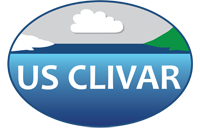Climate Process Teams
For a decade and a half, US CLIVAR has promoted the concept of Climate Process Teams (CPTs). CPTs improve the fidelity of coupled climate models by facilitating the transfer of knowledge from observational and process-oriented research to the development of physical process representation in component ocean or atmosphere global climate models (GCMs). A CPT, as defined by US CLIVAR, is a:
funded multi-institutional project that assembles observation-oriented experimentalists, process modelers, process diagnosticians, theoreticians, and climate model developers from two or more modeling centers into a single project that focuses on a specific process or set of processes to assess model sensitivities to process uncertainties, establish observation and model metrics, and develop, test, and implement parameterization improvements.
NSF and NOAA have co-sponsored two rounds of CPT projects, with the latest projects completing in 2015/16.
In 2015, the US CLIVAR Process Studies and Model Improvement (PSMI) Panel organized a review of CPTs to assess the effectiveness and lessons learned from the CPT approach, main sources of errors/biases in models, opportunities for future model improvement, and potential payoff for future CPT projects. The review committee collected input through questionnaires of seven US modeling center and numerous observational programs, process studies, CPT projects, and US CLIVAR Working Groups, followed by an open community workshop held at NOAA GFDL in September 2015. The information collected informed a 2016 US CLIVAR White Paper.
Below are the key findings from the white paper, best practices for a CPT, and how best to propose a CPT project to the US CLIVAR funding agencies.
Key Findings of White Paper on Translating Process Understanding to Improve Climate Models
- CPTs provide effective mechanisms to facilitate close collaboration and enduring links between process experts and model developers, thereby accelerating scientific understanding of key physical processes and leading to improvements in their representation in climate models.
- Only a limited number of processes have so far been targeted with CPTs; numerous processes and their interactions remain poorly represented in large-scale models, and such models still have many biases that may be improved by better process representation.
- While challenging to coordinate, CPTs involving multiple centers engage a broader range of experience and lead to better science.
- Future multi-agency, multi-modeling center CPT projects are strongly recommended.
It should be noted that CPTs are just one tool among many program and modeling center mechanisms for model improvement.
Best Practices for Pursuing a CPT Project
- Successful CPTs have been focused on specific processes that are known to have an important influence on climate simulation characteristics.
- Observations and theoretical ideas exist to help improve the representation of the process(es) of interest in climate models.
- CPT projects benefit by including multiple models, with a demonstrated buy-in at the scientist level by modeling centers.
- Proposals should include a letter from the participating modeling centers stating their interest and commitment.
- Participation of postdocs and programmers is critical.
- Communication among project participants is essential and should be consistent and ongoing through telecons and annual team meetings.
See Ten tips for building an effective CPT for additional best practices guidance.
Opportunities to Propose CPTs to Federal Agency Programs
National Science Foundation
NSF Physical Oceanography (PO) and Climate & Large-scale Dynamics (CLD) Programs are open to receiving proposals that address improving the representation of processes (rather than improving biases) in the NCAR CESM and component community models. The concept for CPTs has been effectively socialized within the research community and does not necessitate a specific solicitation or Dear Colleague Letter. Instead, interested parties should contact the program managers with a brief one-page outline describing the concept and potential participants to help facilitate cross-agency coordination.
National Oceanic and Atmospheric Administration
NOAA is interested in CPT projects with a traditional focus on model diagnostics and process representation improvements that include collaborations with the NOAA global coupled modeling centers. The NOAA Climate Variability and Predictability (CVP) and Modeling, Analysis, Predictions and Projections (MAPP) Programs will consider support for scientists at NOAA labs, centers, NOAA OAR Cooperative Institutes, and academic research institutions. Awards may be funded in partnership with other agencies participating in US CLIVAR and/or the US Global Change Research Program. NOAA collaborating scientists and those interested in NOAA support should contact Sandy Lucas, NOAA CVP, or Annarita Mariotti, NOAA MAPP, for guidance. The current FY19 NOAA funding opportunity seeks proposals for CPTs.
National Aeronautics and Space Administration
NASA is interested broadly in Earth system modeling with an observational focus and collaboration with NASA GMAO and/or GISS modeling centers. A possible NASA solicitation would be a few years away. In the near term, the NASA Modeling, Analysis, and Prediction (MAP) could provide core-funded participation of scientists at its centers in CPTs. If there is center interest, PIs should consult with David Considine, NASA MAP, at the proposal stage. NASA Physical Oceanography (PO) will consider funding a postdoc at a university or NASA lab (e.g., JPL) for interaction with NASA on a CPT project proposed to another program’s call. Interested PIs should consult with Eric Lindstrom, NASA PO, at the proposal stage.
Department of Energy
DOE is interested in focused projects to engage program priority interests and advance the development and evaluation of the E3SM model (e.g., land/ocean model development, high-resolution data assimilation, coupled modeling, development of process-based metrics for evaluation). DOE does not plan to have a focused CPT call for 2018. DOE modeling programs could support DOE lab scientists collaborating on other agency-sponsored CPTs through base funding. Interested lab scientists should consult with Dorothy Koch and/or Renu Joseph, DOE EESM, at the proposal stage.
Office of Naval Research
ONR is interested in modeling of subseasonal-to-interannual timescale processes and the collaboration of Navy model development (e.g., NAVGEM, HYCOM) and Naval Research Laboratory (NRL) scientists. ONR can consider supporting the participation of NRL scientists on CPT projects proposed to other agencies. PIs should consult with Scott Harper, ONR, at the proposal stage.
Learn more about the previous US CLIVAR CPTs.
